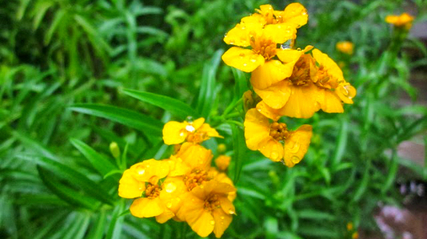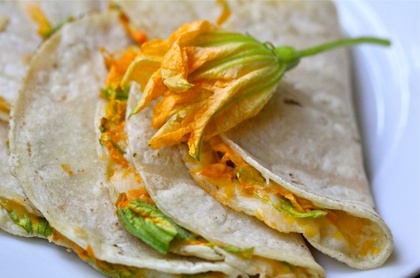makes 6 quesadillas.
Squash blossom and cheese quesadillas are the perfect vegetarian
antojito (light snack) but they taste just as good to us carnivores.
In Mexico the blossoms are available in the markets year-round but
in the States, they are a more seasonal treat (unless you have access
to a good market that imports, or there are local growers with green-
houses).
If you have ever grown squash you quickly realize how prolific the
plants can be. The blossom that you’ll find most often is the male
blossom. Male squash blossoms have little tiny hairs and a thin base
where they attach to the stem. Female flowers have a thick bulge at
the base, which is the ovary, and what will develop into the squash
once a bee carries the male pollen to the female bloom.
Each plant produces both male and female flowers, and a miracle
of nature (and a blessing to your plate) is that the plant will produce
more male blooms than is necessary. Don’t be afraid to harvest a
good share of the males. Female blooms taste better than male
blooms, but if you pick them all, you get no squash. If you’ve ever
gone door-to-door in your neighborhood trying to give away excess
squash from your garden, cutting back the yield a bit isn’t always a
bad thing.
You can use the flowers of summer squash, zucchini, patty pan,
spaghetti, delicata, kuri, pumpkin, acorn, butternut, turban, Hubbard,
chayote, tatuma, calabacita, etc. I would avoid the really fetid gourds,
but any melon blossom should work fine as well.
The flavor is a savory, subtle hint of the adult vegetable, and the
texture is silky. If they have one downfall it is that they have a short
shelf life. You want to harvest them or buy them in the morning if
possible; they wilt in afternoon heat.
The best way to store them is to put a paper towel in a plastic bag
or container to absorb humidity, and gently place the blooms in,
stem side-down, with the petals facing up, and place on the top
shelf of the refrigerator; if you have a wine cooler that’s not as
cold, that’s even better.
Male blooms keep longer than female blooms, up to a week if
you’re lucky. You obviously want organic blossoms, so that you’re
not eating any pesticides, but the nature of growing squash is that
the grower can’t kill the bees or he won’t get any squash. Squash
vine borers are the main insect culprit, and they are handled with Bt
(Bacillus thuringiensis), a bacterial organic pesticide that only kills
caterpillars.
If your squash plants are grown with a hay mulch, the blossoms
should be clean; if grown with no mulch they may have splashed
dirt that needs to be washed off. To prepare the blossoms, break
off the stems and the green sepals at the base of each blossom.
Remove the long pistils in the center of the flower.
Rinse (if necessary), drain well on paper towels, and reserve; keep
them dry or they can succumb to fungal growth. The cheese you
want to use is a fresh, mild, un-aged Mexican-style of white cheese
that melts easily, such as asadero, quesillo, Oaxaca, Chihuahua,
quesadilla, or Monterrey Jack.
You can use fresh, pre-made corn or flour tortillas, or make your
own from masa or maseca dough mix. In Texas we use flour tortillas.
A squash blossom and cheese quesadilla cries out for the herb epazote,
but it can be difficult to find fresh in some parts of the States (a His-
panic market or farmer’s market is your best bet). You can purchase
it dried, or you can substitute cilantro. The ideal salsa to eat with
these quesadillas is my tomatillo and green chile verde sauce (see
recipe below).
____________________________________________________
24 to 36 squash blossoms
1 large poblano pepper, roasted and peeled, stemmed and seeded,
cut into rajas
½ medium white onion, diced
3 large cloves of garlic, minced
¾ teaspoon of dried epazote (or ¼ cup fresh cilantro leaves and tender
stems, minced)
3 cups shredded asadero, quesadilla, Chihuahua, Oaxaca, or Monterrey
Jack cheese
12 tortillas, flour or corn
2 tablespoons olive oil
6 tablespoons of butter
Salt and pepper to taste.
____________________________________________________
1. Clean the squash blossoms by breaking off the stems and the green
sepals at the base of each blossom. Remove the long pistils in the
center of the flower. Rinse, drain, and reserve.
2. Add 2 tablespoons of olive oil to skillet over medium heat. When
shimmering add onion and poblano rajas and cook until onions are
translucent, about 5 to 6 minutes. Add garlic, epazote, squash
blossoms, and salt and pepper to taste and sauté until all the liquid
from the flowers has evaporated, about 8 to 10 minutes.
Remove from heat and reserve.
3. Melt a tablespoon of butter in a medium skillet over medium heat.
Add a tortilla and cook on one side until it puffs up, about 30 seconds.
Flip tortilla over and sprinkle on ¼ cup squash blossom filling and ½
cup grated cheese, covering the entire surface. Top with another tortilla,
and after cheese has melted and bonded the two tortillas, about 2 min-
utes, flip over and cook the opposite side for an additional 2 minutes.
Drain on paper towels and reserve warm. Repeat with the remainder
of the filling, cheese, and tortillas.
4. To serve, cut the quesadillas into wedges, and serve with a roasted
chile and tomatillo sauce.
____________________________________________________
Salsa Verde – Green Sauce with Tomatillo
Makes about 3 cups
This is a great all-around green sauce for the table, ideal on tacos or
dipped with a totopo, and perfect with enchiladas or rice. It can be
broiled-grilled, or simmered. I like the addition of the roasted poblano;
it deepens the color and adds another layer of flavor.
1¾ pounds tomatillos, husked and washed
4 serrano chiles, stem removed (seeds and ribs removed for less heat –
optional)
1 large poblano chile, roasted and peeled, stemmed and seeded,
chopped
4 scallions, root end trimmed
4 cloves garlic, peeled
1 Tablespoon lime juice
¼ bunch cilantro, rinsed well, chopped
½ teaspoon sugar
Salt
Chicken stock or water for thinning, if neccessary.
____________________________________________________
Place the tomatillos, chiles, scallions, and garlic on a half sheet pan
lined with foil or parchment paper and broil until the tomatillos are
slightly blackened and becoming soft; flip them over and cook the
other side. Carefully remove the pan, watching for hot liquids, and
scoop all the ingredients into a food processor or blender, add the
lime juice, cilantro, and sugar and pulse to blend the ingredients into
a slightly chunky sauce. Taste for salt and season, and reserve.
Note: A less flavorful version of this salsa can be made by simmering
the tomatillos, chiles, scallion, and garlic in chicken stock until soft-
ened, but not enough for the tomatillos to split open.
______________________________________________________
Read more of chef / author Mick Vann's stories at gustidude




 Visit the website:
Visit the website: